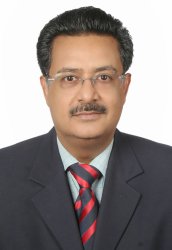Chronic Myeloid Leukemia - a perspective from India
 Dr. Hemant Malhotra is presently Professor of Medicine at the SMS Medical College Hospital & Head of the division of Medical Oncology at the Birla Cancer Center. The SMS Medical College Hospital is a 2000 bedded hospital, one of the leading teaching and patient care center in North India.
Dr. Hemant Malhotra is presently Professor of Medicine at the SMS Medical College Hospital & Head of the division of Medical Oncology at the Birla Cancer Center. The SMS Medical College Hospital is a 2000 bedded hospital, one of the leading teaching and patient care center in North India.
India is a large country with 1.2 billion people and the population is steadily increasing. The majority of the population stays in villages (60 to 70%) and a substantial percentage are still illiterate (30 to 40%). Availability of health care is non-uniform, with medical facilities at par with the best in the world in the metros and large cities and non-existent to rudimentary in interior villages where patients are at the mercy of 'quacks' who still practice medieval medicine (see photos). Only a very small minority of patients (less than 5%) are covered by medical insurance.
Most hematologists and oncologists believe that Chronic Myeloid Leukemia (CML) is the commonest leukemia in adults in India. According to the few existing publications available from the country, age at presentation is at least a decade early as compared to the west, patients present with more advanced disease at diagnosis and have a poorer response to imatinib (possibly due to more advanced disease at presentation).
Generic imatinib is available in India (approximate monthly cost USD 100 to 200, depending on the brand) but many patients are unable to afford even this. As of February 2010, there are 12,224 patients (about 70 to 80% of all CML patients) on GIPAP (Glivec International Patient Assistance Program) Glivec which is provided without cost. Approximately 160 to 170 new applications per month are received by the MAX Foundation – the agency running the GIPAP program in India since 1991. For entry into the GIPAP program, one of the criteria is demonstration of the Ph chromosome by karyotyping or bcr/abl gene by either FISH or RT-PCR. Quite a few patients who would otherwise be candidates for free Glivec under GIPAP, are unable to afford these tests. Most patients on GIPAP Glivec and quite a few on generic imatinib are unable to get 3 or 6 monthly or even annual testing for bcr/abl gene copy numbers for response monitoring and it is quite usual for clinicians to get to know about imatinib resistance only after frank hematological relapse. Even if early molecular relapse is identified in a small subset of patients, only a tiny minority of these would be able to afford second-line treatment.
With regards to CML, priorities in India include availability of free/ subsidized, standardized and reliable testing for bcr/abl at all state medical college institutions and cancer centers at diagnosis and for monitoring during therapy for all patients, kinase domain mutational testing at few referral centers and regional cancer centers and GIPAP-like support program for second line drugs (dasatinib and nilotinib). There is also a need to get together a group of clinicians, hematologists & oncologists interested in CML who could address India-specific problems, suggest and implement solutions; and direct India-specific research in the field.
The iCMLf could assist in each one of the above-mentioned priority areas.
Professor Hemant Malhotra
SMS Medical College, Jaipur (India)
iCMLf Scientific Advisory Committee member










